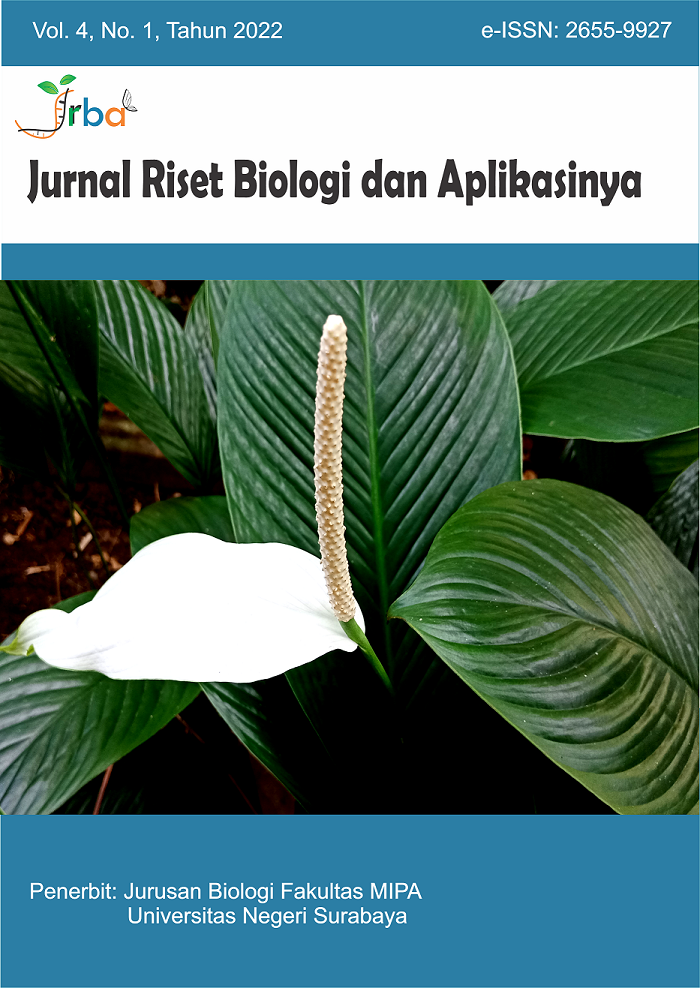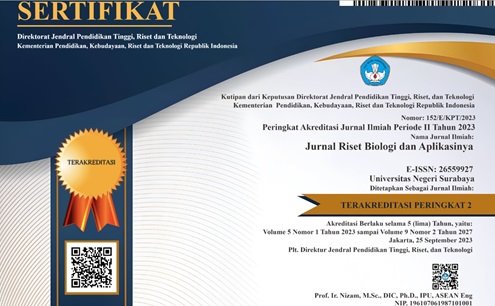Ability Test of IAA (Indole-3-Acetic Acid) Hormone-Producing Endophytic Bacteria from Lamongan Mangrove
DOI:
https://doi.org/10.26740/jrba.v4n1.p42-50Keywords:
no addition informationAbstract
Most of the plant-associated bacteria can synthesize active biological components of phytohormones such as auxin. This study aimed to examine the potency of 61 endophytic bacteria isolates from the mangroves at Kutang Beach, Lamongan in producing IAA hormone and to identify types of isolates effecting the concentration of IAA, morphological characteristics of isolates, as well as endophytic bacterial species that have the most potential to produce IAA hormone. Screening of endophytic bacteria isolates was performed using the colorimetric method and the production of IAA was carried out using the spectrophotometric method. IAA production by endophytic bacteria was analyzed descriptively and statistically. One-Way ANOVA was employed to determine the effect of the isolate type on the concentration of IAA. The most potential isolates to produce IAA hormone are identified by 16s rRNA gene marker. The screening results showed that 12 isolates of endophytic bacteria have the potential to produce IAA hormones (2.0-9.3 ppm), coded with LMG 7, 15, 31, 32, 43, 53, 54, 55, 56, 57, 62, and 63. The results of the One-Way ANOVA test suggested that the type of isolates did not affect the concentration of IAA produced by endophytic bacteria. The twelve isolates had different morphological characters and those were Gram-positive bacilli with cell sizes ranging from 1.5 µm - 3 µm. The highest concentration of IAA was produced by LMG 15 (9.3 ppm). LMG 15 was identified as Bacillus cereus strain LMG 15, having 99.33% similarity to Bacillus cereus strain IAM 12605.
References
Acuna, J. J. Jorquera, M. A. Martinez, O. A. Menezes-Blackbum, D. Greiner, P. dan Mora, M. L. (2011). Indole Acetic Acid and Phytase Activity Produced by Rhizosphere Bacilli as Affected by pH and Metals. Journal Soil Science Plant Nutrition, 3 (11), 1-12. http://dx.doi.org/10.4067/S0718-95162011000300001
Ahemad, Munees dan Mulugeta, K. (2014). Mechanism and application of plant growth promoting rhizobacteria: Current perpective. Journal of King Saud University-Science, 26, 1-20. https://doi.org/10.1016/j.jksus.2013.05.001
Apine, O. A. and J.P. Jadhav, 2011. Optimization of medium for indole-3-acetic acid production using Pantoea agglomerans strain PVM. J. Appl. Microbiol, 110(5), 1235–1244
Duca, D., J. Lorv, C. L. Patten, D. Rose and B.R. Glick, 2014. Indole-3-acetic acid in plant – microbe interactions. Antonie van Leeuwenhoek, 106, 85–125
Herdiyanto, D. dan Setiawan, A. (2015). Upaya Peningkatan Kualitas Tanah melalui Sosialisasi Pupuk Hayati, Pupuk Organik, dan Olah Tanah Konservasi di Desa Sukamanah dan Desa Nanggerang Kecamatan Cigalontang Kabupaten Tasikmalaya. Dharmakarya Jurnal Aplikasi Ipteks untuk Masyarakat, 4(1), 47-53. 10.24198/dharmakarya. v4i2.10028
Idris, E. E. Iglesias, D. J. Talon, M. dan Borris, R. (2007). Tryptophan-dependent production of Indole-3-acetic acid (IAA) affects level of plant growth promotion by Bacillus amyloliquefaciens FZB24. Molecular plant-microbe interactions, 20(6), 619-626. DOI:10.1094/MPMI-20-6-0619
Irawan, Bambang. Fatimah. Intan, A. P. Moch, Affandi. Ketut, W. Lilik, B.P. dan Thin, S. (2019). Development of mangrove healthy condition (MHC) index based on their symbiotic organisms. Ecology, Enviroment and Conservation. 2019 (pp. S37-S42). Link Url. https://www2.scopus.com/inward/record.uri?eid=2-s2.0-85070670260&partnerID=40&md5=ddce70f68ddbdfd822748f3a85c7a341
Janda, J. M. dan Abbott, S. L. (2007). 16S rRNA Gene Sequencing for Bacterial Identification in the Diagnostic Laboratory: Pluses, Perils, and Pitfalls. Journal of Clinical Microbiology, 45(9), 2761-2764
Kartikawati, A. Trisilawati, O. dan Darwati, I. (2017). Pemanfaatan Pupuk Hayati (Biofertilizer) pada Tanaman Rempah dan Obat/Biofertilizer Utilization on Spices and Medicinal Plants, Perspektif, 16(1), 33-43. http://dx.doi.org/10.21082/psp.v16n1.2017.33-43
Kearse, M. Moir, R. Wilson, A. Stones-Havas, A. Cheung, M. Sturrock, S. Buxton, S. Cooper, A. Markowitz, S. Duran, C. Thiere, T. Ashton, B. Meintjes, P. dan Drummond, A. 2012. Geneious Basic: An Integrated and Extendable Dekstop Software Platform for The Organization and Analysis of Sequence Data. Bioinformatics Aplication Note, 28(12), 1647-1649. DOI: 10.1093/bioinformatics/bts199
Khalid, A. Arshad, M. dan Zahir, Z.A. (2004). Screening Plant Growth-Promoting Rhizobacteria for Improving Growth and Yield of Wheat. Journal of Applied Microbiology, 96, 473-480. 10.1046/j.1365-2672.2003. 02161.x
Liu, H., L.C. Carvalhais, M. Crawford, E. Singh, P.G. Dennis, C. M. Pieterse and Schenk, P. M., 2017. Inner Plant Values: Diversity, Colonization and Benefits from Endophytic Bacteria. Front. Microbiol, 8 , 2552
Lwin, K.M. Moe, M.M. Tar, T. dan Aung, Z.M. (2012). Isolation of Plant Hormone indole-3-acetic acid producing rhizobacteria and study on their effects on maize seedling. Engineering Journal, 16(5),138-144. https://doi.org/10.4186/ej.2012.16.5.137
NCBI News. (2006/7). New Database and View Options for Nucleotide BLAST Services. 15(2). Diakses melalui https://www.ncbi.nlm.nih.gov/Web/Newsltr/V15N2/BLView.html pada tanggal 22 Mei 2021
Patil, V. (2011). Production of Indole Acetic Acid by Azotobacter sp, Recent Research Science and Technology. 3(12), 14-16. Link Url: https://updatepublishing.com/journal/index.php/rrst/article/view/839
Patten, C.L. dan Glick, B.R. (2002). Role of Pseudomonas putida Indole Acetic Acid in Development of The Host Plant Root System, Applied and Environmental Microbiology, 68(8), 3795-3801. 10.1128/AEM.68.8.3795-3801.2002
Radji M. (2005). Peranan bioteknologi dan mikroba endofit dalam pengembangan obat herbal. Majalah Ilmu Kefarmasian, 2, 113-126. 10.7454/psr.v2i3.3388
Ramadhani, S. I. Sitoresmi, S. P. Agung, A. W. Rina, R. T. S. dan Achmad, A. R. (2020). Quantitative assay of Indole Acetic Acid-producing bacteria isolated from several lakes in East Java, Indonesia. Biodiverstitas Journal of Biological Diversity, 21(11), 5448-5454. https://doi.org/10.13057/biodiv/d211153
Sergeeva, E., A. Liaimer and Bergman. (2002). Evidence for production of the phytohormone indole-3-acetic acid by cyanobacteria. Planta, 215(2), 229–238
Suhandono, S. Kusumawardhani, M. K. dan Aditiawati, P. (2016). Isolation and Molecular Identification of Endophytic Bacteria from Rambutan Fruit (Nephelium lappaceum L.) Cultivar Binjai. Hayati Journal of Bioscience, 23, 39-44
Tsavkelova, E. A. Cherdyntseva, T. A. Klimova, S. Y. Shestakov, A. I. Botina, S. G. dan Netrusov, A. I. (2007). Orchid-associated bacteria produce indole-3-acetic acid, promote seed germination, and increase their microbial yield in response to exogenous auxin. J Arch Microbiol, 188(6), 655-664. 10.1007/s00203-007-0286-x
Vandeputte, O. Oden, S. Mol, A. Vereecke, D. Goethals, K. El Jaziri, M. dan Prinsen, E. (2005). Biosynthesis of auxin by the gram-positive phytopathogen Rhodococcus fascians is controlled by compounds specific to infected plant tissues. Applied and environmental microbiology, 71(3), 1169-1177. 10.1128/AEM.71.3.1169-1177.2005
Wahyudi, A.T. Astuti, R.P. Widyawati, A. Meryandini, A. Nawangsih, A.A. (2011). Characterization of Bacillus sp. strains isolated from rhizosfere of soybean plants for their use as potential plant growth for promoting rhizobacteria. Journal of Microbiology and Antimicrobials, 3, 34-40. Link https://www.internationalscholarsjournals.com/articles/characterization-of-bacillus-sp-strains-isolated-from-rhizosphere-of-soybean-plants-for-their-use-as-potential-plant-gro.pdf
White, J. F., K.L. Kingsley, Q. Zhang, R.Verma, N. Obi, S. Dvinskikh, M.T. Elmore, S.K. Verma, S. K. Gond and Kowalski, K. P., 2019. Review: Endophytic microbes and their potential applications in crop management. Pest Manag. Sci, 75(10), 2558–2565
Ying, W. Cheng-de, Y. Yu-ling, Y. Yu-qin, W. Zhen-fen, Z. dan Li-X. (2016). The Diversity and Potential Function of Endophytic Bacteria Isolated from Kobreasia capillifolia at Alpine Grasslands on The Tibetan Plateau, China. Journal of Integrative Agriculture, 15(9) 2153-2162. 10.1016/S2095-3119(15)61248-5g.
Downloads
Published
How to Cite
Issue
Section
License
Copyright (c) 2022 Jurnal Riset Biologi dan Aplikasinya

This work is licensed under a Creative Commons Attribution-NonCommercial 4.0 International License.
Authors who publish with this journal agree to the following terms:

This work is licensed under a Creative Commons Attribution-NonCommercial 4.0 International License.
Copyright Notice
The copyright of the received article once accepted for publication shall be assigned to the journal as the publisher of the journal. The intended copyright includes the right to publish the article in various forms (including reprints). The journal maintains the publishing rights to the published articles.
The publisher publish and distribute the Article with the copyright notice to the JRBA with the article license CC-BY-NC 4.0.
 Abstract views: 586
,
Abstract views: 586
, PDF Downloads: 475
PDF Downloads: 475























